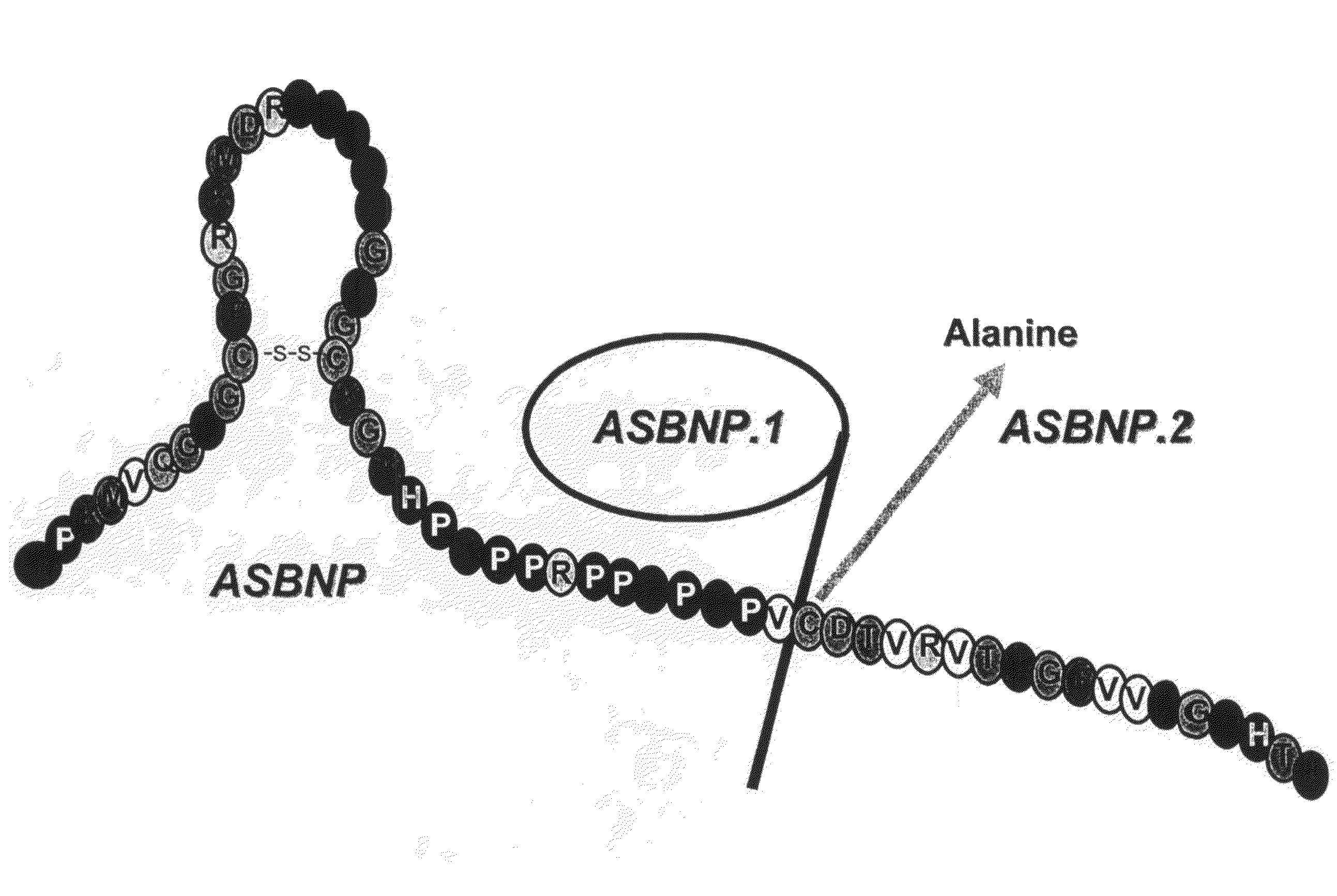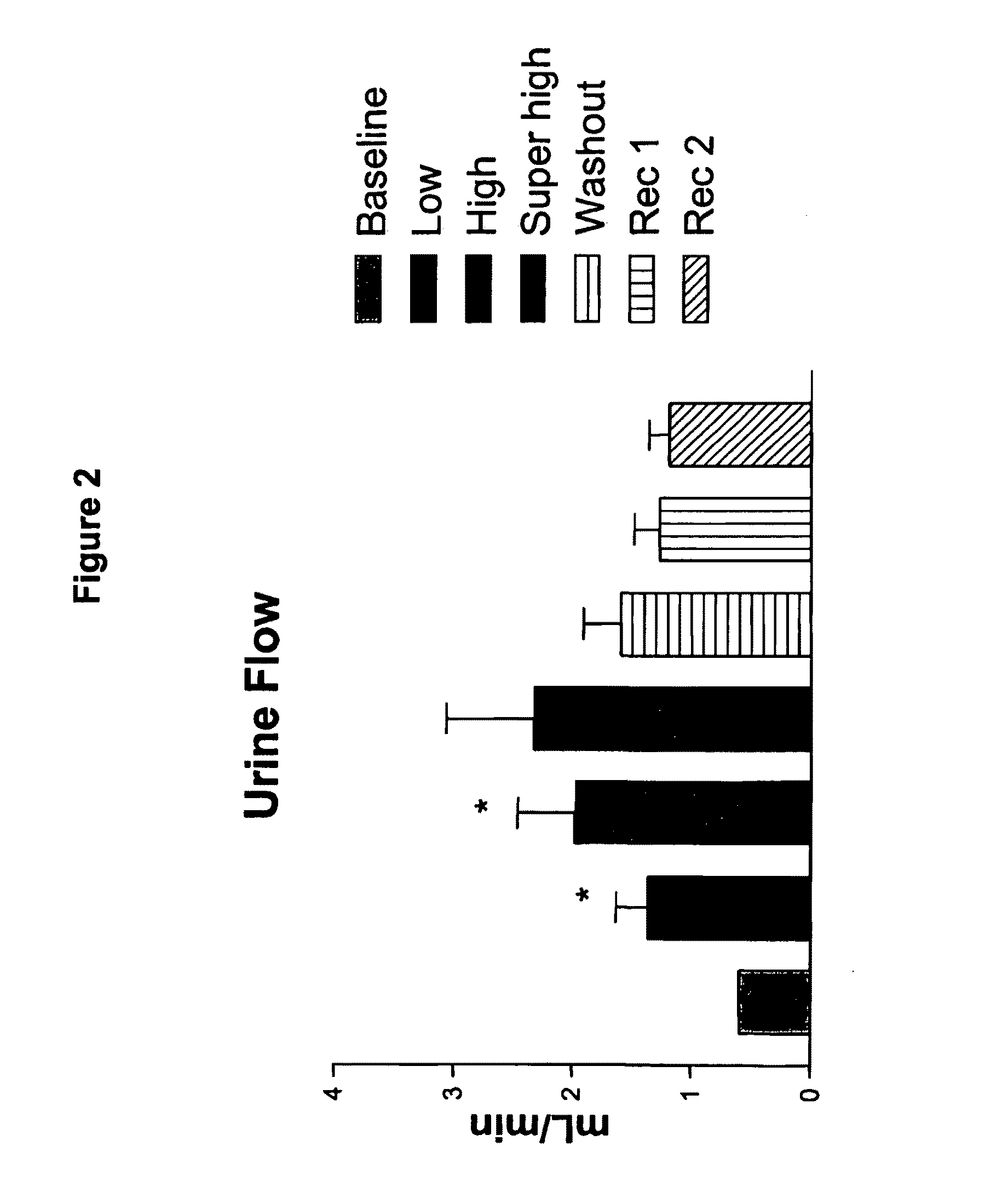Diuretic and natriuretic polypeptides
a technology of natriuretic polypeptides and diuretic activity, which is applied in the field of diuretic and natriuretic polypeptides, can solve the problems of lack of ability to lower blood pressure, and achieve the effect of increasing diuretic and natriuretic activity, without lowering blood pressure, and lowering blood pressur
- Summary
- Abstract
- Description
- Claims
- Application Information
AI Technical Summary
Benefits of technology
Problems solved by technology
Method used
Image
Examples
example 1
Biological Effects of ASBNP.1 Polypeptides
[0107]A truncated form of ASBNP that terminates prior to the cysteine and contains a 13 amino acid C-terminus tail was designed and synthesized. This polypeptide is referred to as an ASBNP.1 polypeptide (FIG. 1). The biological effects of intravenous ASBNP.1 infusion were tested in normal dogs. Briefly, six normal dogs were infused with 2, 10, and 100 pmol of an ASBNP.1 polypeptide preparation, i.e., each dog received consecutive infusions of 2, 10, and 100 pmol of an ASBNP.1 polypeptide preparation. Urine flow, urinary sodium excretion, distal fractional tubular sodium reabsorption, proximal tubular fractional sodium reabsorption, mean arterial blood pressure, plasma cGMP levels, glomerular filtration rate, renal blood flow, and plasma renin levels were measured as described elsewhere (Chen et al., Am. J. Physiol. Regul. Integr. Comp. Physiol., 288: R1093-R1097 (2005) and Haber et J. Clin. Endocrinol. Metab., 29:1349-1355 (2005)). Systemic ...
example 2
Biological Effects of ASBNP.1 Polypeptides in Mammals with CHF
[0110]The biological effects of intravenous ASBNP.1 infusion were tested in a paced dog model of congestive heart failure (CHF). Briefly, 10 dogs underwent surgical implantation of a programmable cardiac pacemaker (Medtronic, Minneapolis, Minn.). After postoperative recovery, the animals received 11 days of rapid ventricular pacing (240 beats / minute), which can induce overt congestive heart failure CHF as described elsewhere (Chen et al., Circulation, 100:2443-2448 (1999)). The dogs were intravenously infused with 2, 10, and 100 pmol of an ASBNP.1 polypeptide preparation, i.e., each dog received consecutive infusions of 2, 10, and 100 pmol of an ASBNP.1 polypeptide preparation.
[0111]Acute hemodynamic studies were performed at the time of infusion, and comparisons were made between groups and among dogs at baseline and during each infusion. Urine flow, urinary sodium excretion, distal fractional tubular sodium reabsorption...
example 3
Biological Effects of ASBNP.1 Polypeptides Using Animal Models
[0114]The effects of ASBNP.1 infusion is further assessed in the TIVCC model (a dog model of sodium retention which mimics cirrhosis and nephrosis). The TIVCC model of sodium-retention and ascites without concurrent increases in cardiac filling pressure as described elsewhere (Wei et al., Am. J. Physiol., 273:R838-844 (1997)). The ASBNP.1 polypeptide is tested in the TIVCC model using increasing doses up to 100 pmol·kg / minute administered intravenously.
PUM
| Property | Measurement | Unit |
|---|---|---|
| length | aaaaa | aaaaa |
| blood pressure | aaaaa | aaaaa |
| nucleic acid | aaaaa | aaaaa |
Abstract
Description
Claims
Application Information
 Login to View More
Login to View More - R&D
- Intellectual Property
- Life Sciences
- Materials
- Tech Scout
- Unparalleled Data Quality
- Higher Quality Content
- 60% Fewer Hallucinations
Browse by: Latest US Patents, China's latest patents, Technical Efficacy Thesaurus, Application Domain, Technology Topic, Popular Technical Reports.
© 2025 PatSnap. All rights reserved.Legal|Privacy policy|Modern Slavery Act Transparency Statement|Sitemap|About US| Contact US: help@patsnap.com



